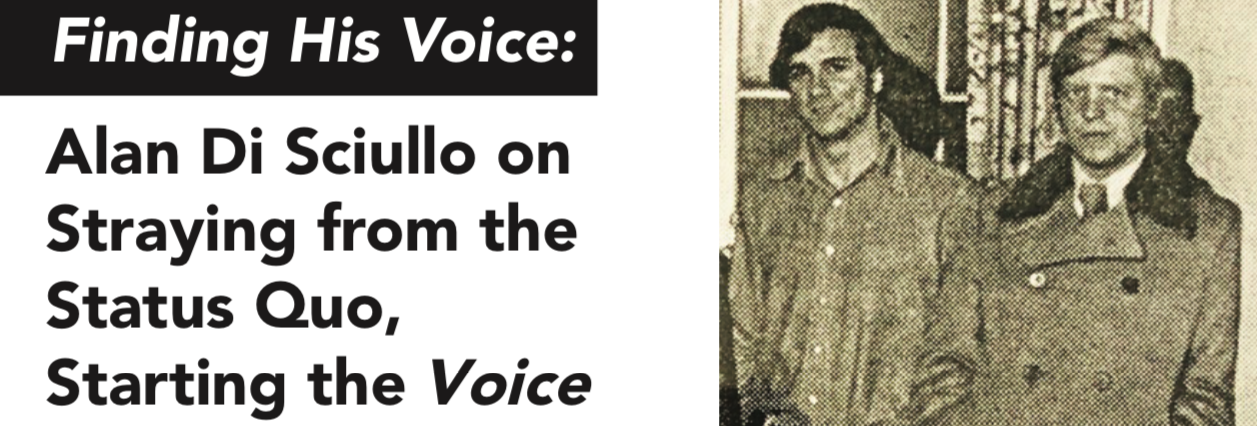“We wanted to start something more dynamic,” Alan Di Sciullo (COL ’72, L ’77) said, reflecting on the beginnings of The Georgetown Voice. “The experience of being managing editor of a college paper, especially one that was growing the way we were, was a tremendous experience.”
The Voice’s growth was propelled by a radicalized environment of student protests on campus and nationwide in the late ’60s. That’s when Di Sciullo, who was a sports writer, Stephen Pisinski (COL ’71), and a group of editors split from The Hoya over the newspaper’s restrictive scope and conservative editorial angle. Di Sciullo co-authored the first editorial in the inaugural issue of the Voice published on March 4, 1969. The editorial articulated the new paper’s goal to expand its content to encompass off-campus news that affected students and to cover issues in a more “liberal light.”
“We promise to present and analyze national and local issues of concern to the student, whose concern should spread beyond the campus,” wrote Di Sciullo and his co-authors. “We shall attempt with all our energy to inform the community, to make the community conscious of controversial subjects by an open presentation and discussion of relevant issues, to communicate a culture, and to entertain our readers.”
They quickly realized, however, that starting a new publication from the ground up required far more work than reforming the existing one.
While it was a team effort, Di Sciullo said much of the Voice’s initial success should be credited to Pisinski, its first editor-in-chief. “Steve was a straight arrow,” Di Sciullo said of his friend and colleague. “He was down to earth, not flamboyant. He ran a tight ship.”
Di Sciullo, who served as both the business and managing editor, said the Voice had a tangible impact on the Georgetown community during the political and social unrest of the late ’60s. The new paper created a pathway for more forums, more opinions, and more voices.
Though they were not necessarily on the same side of the political spectrum, Di Sciullo recalled that members of the Voice always promoted collaboration and cooperation. He cited his close relationship with fellow Voice member Rick Newcombe (COL ’72), editor-in-chief from 1971 to 1972, as a good example of this. “Rick was from a conservative family,” Di Sciullo said. “I was probably more middle of the road, slightly liberal.” However, the two successfully navigated their political differences to function as a unit on the publication. Di Sciullo said that the
Voice’s ability to fairly represent a variety of political views reflected Georgetown itself, which he believes is a place where different points of view are accepted.
Di Sciullo’s favorite part of student journalism was having a voice and being able to tell a story. At the Voice, he could write about events beyond campus and in the city. He said it was for this extended scope that people welcomed the Voice, despite it being a new and unfamiliar paper compared to The Hoya’s already 50-year history. “People liked it,” Di Sciullo said. “It was novel at the time, a little bit edgy.”
Since his time with the Voice, Di Sciullo has written upwards of 50 professional articles and has co-authored a book on real-estate legal issues, his area of expertise. In addition to his job as a real estate attorney in New York, Di Sciullo earned the title of Super Lawyer in 2008, was elected vice chair of the American Bar Association’s Real Property Trust and Estate, and is currently the director of global real estate for Shearman & Sterling LLP.
To this day, Di Sciullo credits the Voice with giving him various skills that he carried with him through his undergraduate studies, Georgetown Law, and beyond. “I learned to work with facts, which I have to do in law. I learned to be more comfortable with writing, which I had to do in briefs,” Di Sciullo said. “I knew that if I was going to go to law school, I had to learn how to write.” He added that attending Georgetown gave him the “direction and confidence” that he needed later in his life.
With the 50th anniversary of the Voice approaching in March, Di Sciullo is proud that the paper has been able to continue. “Time has shown that there is a place for two newspapers at Georgetown,” he said.
After the Voice’s founding, The Hoya began to expand its reporting to news across the city to match the new publication’s reach. Di Sciullo remembered that in 1970,The Hoya approached the Voice and proposed a merger. The Hoya publicized their proposal in a front-page article on Nov. 12, 1970, where Don Casper (COL ’70), The Hoya’s editor-in-chief, claimed that the “ideological differences that lead to the founding of the Voice no longer exist.” Although Di Sciullo, Pisinski, Newcombe, and other Voice members discussed the idea, they eventually rejected the offer because they were excited about the direction the Voice’s coverage was moving in, compared to their former paper. “We were scrapping for ourselves and our existence and reaching an audience,” Di Sciullo said.
“They were the status quo. We had momentum on our side.”





